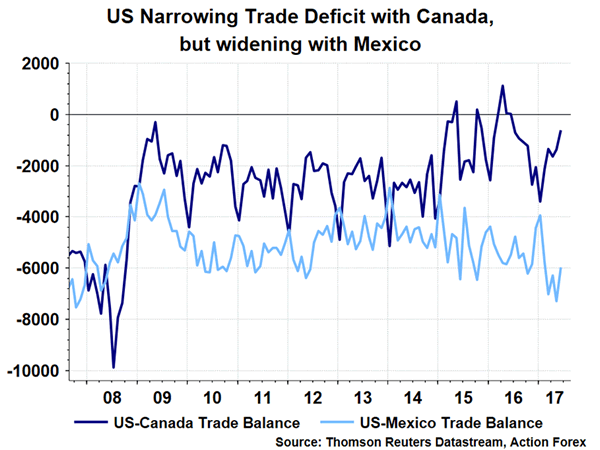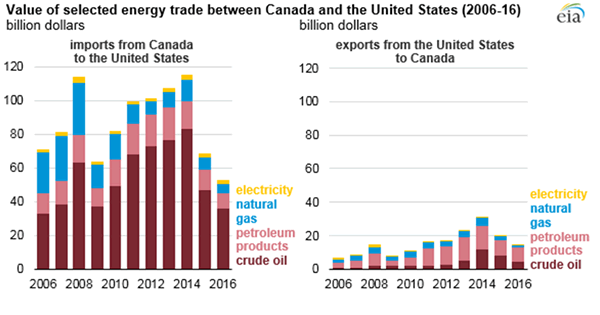US President Donald Trump’s renewed threat to withdraw from the North America Free Trade Agreement (NAFTA) reminds us that renegotiation of this 23-year-old deal has begun. While the US has accused Canada of both lumber and dairy trades, its focus is more on Mexico with Trump keeping demanding its third trading partner to pay the bill for construction of the wall along the border. In our opinion, the core of NAFTA renegotiation is to narrow US’ trade deficit. With US’ trade deficit with Canada on the fall, it would put harder pressure on Mexico in the negotiations. The market reaction towards NAFTA renegotiation has been muted, overshadowed by other events including North Korean peninsula tensions, US debt ceiling, and central banks’ monetary policy outlook. Indeed, we do not expect to see material developments for the rest of the year. However, the parties, especially the US and Mexico, would be eager to complete a deal by mid-2018, ahead of and Mexican election in July and US mid-term election in November.
What is NAFTA?
NAFTA is a trade agreement between Canada, Mexico and the US that became effective in 1994 under President Bill Clinton. Like other FTAs, NAFTA eliminated almost all tariffs among the three states. Barriers on the cross-border flow of services are removed. However, it upholds the protection of intellectual property rights and allows each country to apply its own environmental standards. NAFTA is currently the world’s largest free trade agreement with the three states contributing over US$20 trillion in terms of GDP.
Aim of Renegotiation
During his election campaign, Donald Trump had repeatedly criticizing NAFTA, claiming that it is a "disastrous trade deal" and the cause of the US job loss. Since he has been in office as the US President, Trump has sometimes threatened to terminate the deal although and sometimes indicated the willingness to renegotiate a new agreement. Despite his inconsistence, USTR on May 18 gave formal notice to the Congress that the President intended to commence negotiations with Canada and Mexico with respect to the agreement. After the 90-day consultation period, the first round of talks eventually took place in the US and concluded in August 20, failing to narrow down the divergence amongst the three countries, though. The second round of NAFTA talks would be held form September 1-5 in Mexico, followed by another round scheduled later in September in Canada, before returning to the US.
Reduction on US Trade Deficit
At the "Summary of Objectives for the NAFTA Renegotiation" released in July, the Office of the United States Trade Representative (USTR) lain down the rationale for the renegotiation of this 23-year-old free trade relations among the US, Canada and Mexico. The essence of this 17-page summary is to "improve the US trade balance and reduce the trade deficit with the NAFTA countries". Other critical issues, including the rules of origin, elimination of the Chapter 19 dispute settlement mechanism and the increase in duty-free threshold (DMT) on e-commerce, are aimed at achieving a better trade position for the US

US-Canada
Together with China, Canada and Mexico are the top three trading partners with the US. The US has incurred most deficit with China but this would be dealt separately. In 2016, the US incurred a trade deficit of US$11B in goods with Canada but at the same time enjoyed a trade surplus in services of US$ 24.6B. Therefore, the focus of the US is in goods, not services. Indeed, the US goods deficit with Canada mainly lies on oil and gas trade. In a report released in March, the EIA indicated that energy accounted for about 5% of the value of all US exports to Canada and more than 19% of the value of all US imports from Canada in 2016. The value of US energy imports from Canada was US$ 53B, while the value of US energy exports to Canada was US$14B, last year. As a result, the US incurred a deficit of US$39B in energy trade alone with Canada last year. We expect the "problem" would ease in coming years as the US has become more and more self-reliant on oil production. Meanwhile, we notice that US’ deficit with Canada has decreased for a second consecutive year, falling to the current level from US$ 36.5B in 2014

US-Mexico
Assuming US’ self-reliance on oil production would lead to the decline in demand for Canadian oil, US’ goods trade deficit with Canada would continue to narrow in the future. It is therefore prudent to believe that the US to put more pressure on Mexico in the NAFTA negotiation. Widening for three years in a row, US’ trade deficit with Mexico increased +4.3% to US$ 63B in 2016, with vehicles, machinery, agricultural products the major imports to the US.
Lack of progress has been made in the first round of talks. Trump even renewed threat to leave NAFTA over the weekend, days before the beginning of the second round. Trump twitted that Canada and Mexico were "very difficult" over the renegotiation. He repeated that it was the "worst trade deal ever made", adding "may have to terminate?". Mexico responded by indicating it would not negotiate the trade deal via social media! The third largest trading partner of the US has recently trying to strengthen the relations with China, as it looks for an alternative in trade.

We do not expect any breakthrough in the second round of talks that begins on September 1. All parties would unlikely compromise in early stages of the negotiation. Our base case is that a deal would be reached eventually as we believe the US withdrawal from NAFTA is a "lose-lose" scenario that no party wants. While there might lack progress for the rest of the year, the parties would hope to reach a deal in the first half of 2018, before the Mexican election in July and the US mid-term election in November. The case would be complicated if a deal cannot be completed before the Mexican election. Opinion polls show that the leftist Morena party still gets the most support. Its leader, the populist Andrés Manuel López Obrador (a.k.a. AMLO), is opposing more aspects of the NAFTA and is against Trump. Although market reaction to recent rounds of negotiations would remain rather muted, we believe financial market volatility would increase as we approach July 2018.













